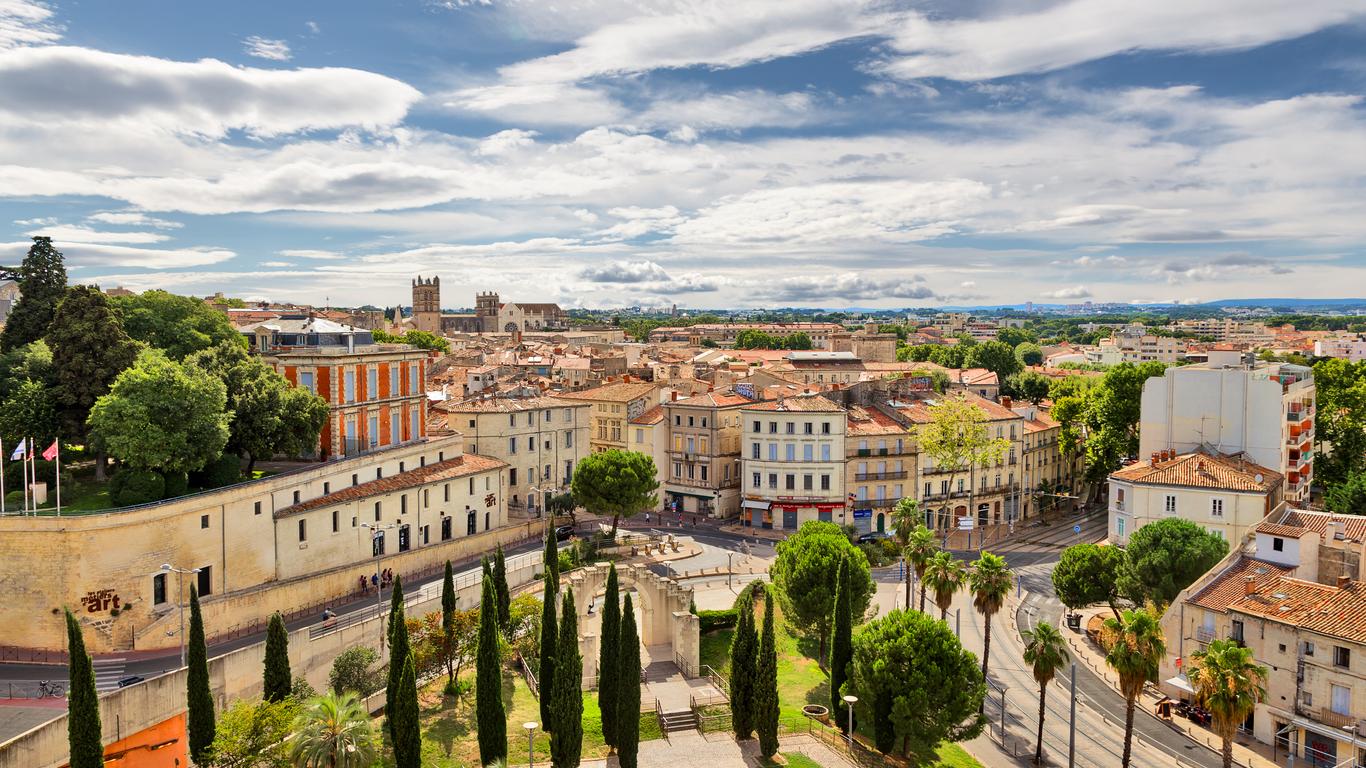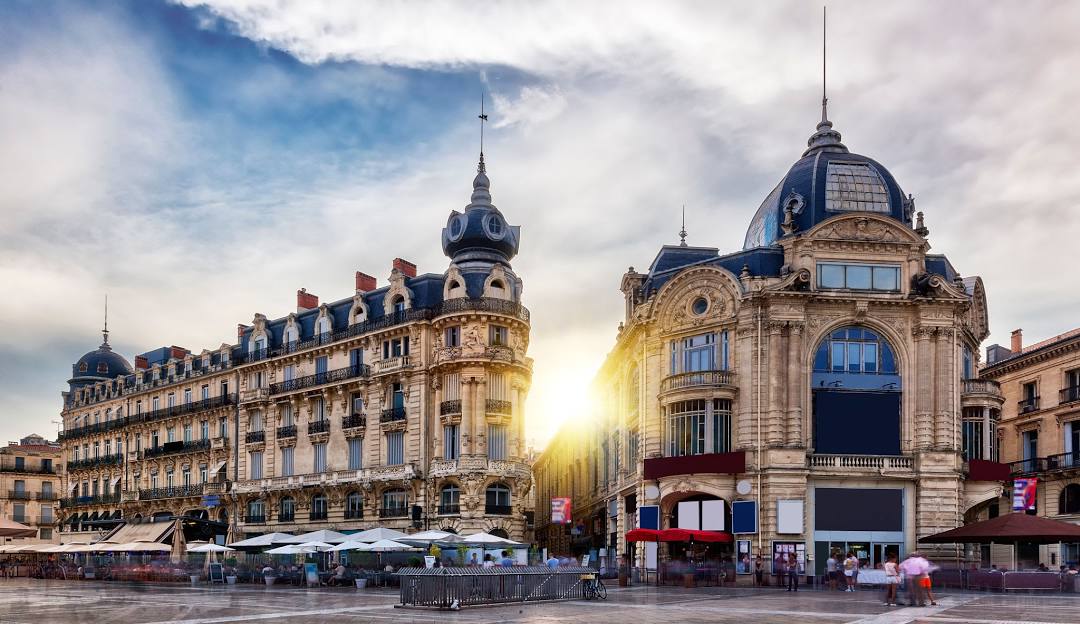Montpellier is a city in southern France, 10km inland from the coast of the Mediterranean Sea. The town's stately Gothic Cathédrale Saint-Pierre, distinguished by conical towers, dates to 1364. The city's Antigone district is a chic, modern development inspired by neoclassical motifs. Paintings from French and European Old Masters hang at the Musée Fabre.
Best Time to Visit Montpellier
Spring (April to June):
- Weather: Enjoy mild temperatures and plenty of sunshine, perfect for exploring the city’s historic center and outdoor cafés.
- Atmosphere: The city blooms in spring with gardens in full blossom and a festive spirit, making it ideal for sightseeing and outdoor activities.
- Events: Look out for local festivals, art exhibitions, and cultural events that often take place during this season.
Autumn (September to October):
- Weather: Experience comfortable temperatures and crisp air, ideal for walking tours and enjoying outdoor terraces.
- Atmosphere: With the summer crowds dwindling, autumn offers a more relaxed vibe while still retaining a lively cultural scene.
- Highlights: Enjoy seasonal culinary delights and local markets as the region transitions into fall.
Summer (July and August):
- Weather: Hot and sunny days are typical, making it a great time for day trips to nearby beaches along the Mediterranean.
- Considerations: While the city buzzes with energy and events, it can be crowded, and accommodations may be at a premium during this peak season.
Winter (November to March):
- Weather: Winters in Montpellier are generally mild compared to northern France, although it can be rainy.
- Atmosphere: The quieter season is great for those who prefer a more peaceful experience while still enjoying the city’s cultural offerings and local cuisine.
How to Get to Montpellier
By Air:
- Montpellier–Méditerranée Airport:
- Location: Approximately 7 km from the city center.
- Connections: The airport serves both domestic and international flights.
- Transport Options: Easily accessible by shuttle buses, taxis, or the tram (Line 1 connects the airport to central Montpellier).
By Train:
- TGV (High-Speed Train):
- Service: Montpellier is well connected via France’s TGV network, with direct routes from Paris, Lyon, Marseille, and other major cities.
- Arrival Station: The main station, Montpellier Saint-Roch, is conveniently located in the heart of the city.
- Regional Trains:
- Service: Numerous regional lines connect Montpellier to nearby towns and cities, making it an ideal hub for exploring the Occitanie region.
By Bus/Coach:
- Long-Distance Buses:
- Providers: Several companies offer coach services linking Montpellier with other French and European cities.
- Cost-Effective: Buses can be a budget-friendly option, though travel times may be longer compared to trains.
By Car:
- Driving:
- Routes: Montpellier is accessible via major highways such as the A9 and A75, making it convenient if you plan to explore the surrounding region by car.
- Considerations: City center parking can be limited and expensive; consider park-and-ride options or using local public transportation once you arrive.
Local Transportation:
- Trams and Buses:
- Montpellier boasts an efficient public transit system, including trams and buses, that makes navigating the city easy and convenient.
- Biking and Walking:
- The city’s compact layout and pleasant climate make cycling and walking popular ways to explore its historic streets and green spaces.
Top Attractions in Montpellier
-
Place de la Comédie
- Overview: Often considered the beating heart of Montpellier, this lively square is surrounded by theaters, cafés, and shops.
- Highlights: Soak up the vibrant atmosphere and enjoy people-watching from a terrace café.
-
Promenade du Peyrou
- Overview: A grand, open-air promenade offering sweeping views of the city.
- Highlights: Admire the Statue of Louis XIV and the Arc de Triomphe-like structure, while strolling through landscaped gardens.
-
Musée Fabre
- Overview: One of France’s leading fine arts museums, hosting a rich collection of European art from the Renaissance to modern times.
- Highlights: Explore diverse exhibitions and masterpieces that illustrate the region’s cultural heritage.
-
Le Jardin des Plantes
- Overview: Established in the 16th century, this is France’s oldest botanical garden.
- Highlights: Wander among exotic plants and serene pathways—a perfect spot for relaxation.
-
Saint Pierre Cathedral
- Overview: A striking Gothic cathedral located in the old town.
- Highlights: Marvel at its architectural details and historical significance.
-
Antigone District
- Overview: A modern district designed by architect Ricardo Bofill, featuring neoclassical architecture and spacious boulevards.
- Highlights: Enjoy the contrast between historic Montpellier and its contemporary urban renewal.
-
Historic Old Town
- Overview: Discover winding medieval streets, hidden courtyards, and vibrant local markets.
- Highlights: Immerse yourself in the charm of centuries-old architecture mixed with modern boutiques and eateries.
Activities to Do in Montpellier
Accommodation in Montpellier
Montpellier offers a wide array of lodging options tailored to different budgets and tastes:
Food and Restaurants in Montpellier
Montpellier’s gastronomic offerings are a reflection of its Mediterranean location and Occitan heritage. From traditional dishes to contemporary culinary innovations, the city caters to all palates:
Local Culture in Montpellier
Montpellier’s cultural scene is as diverse as its food, blending historical charm with youthful innovation:
-
Historical and Architectural Heritage:
- Medieval Roots: Wander through Montpellier’s old town and discover a labyrinth of narrow streets, ancient stone buildings, and hidden courtyards that echo its medieval past.
- Modern Urban Design: The city is also celebrated for its contemporary districts, such as Antigone, where neoclassical architecture meets modern planning—a striking contrast to the historic center.
-
Artistic and Creative Vibes:
- Vibrant Arts Scene: Home to numerous galleries, street art, and cultural festivals, Montpellier attracts artists and creative minds. The blend of tradition and modernity is evident in public spaces that frequently host art installations and live performances.
- Cultural Festivals: The city’s calendar is filled with events ranging from music and theater festivals to art fairs and film screenings, offering plenty of opportunities to experience local talent and innovation.
-
Student and Youthful Energy:
- Academic Hub: With several renowned universities, Montpellier has a lively, youthful atmosphere. The student population infuses the city with energy, reflected in its vibrant nightlife, trendy bars, and innovative culinary spots.
- Dynamic Community: This youthful spirit encourages a culture of experimentation and creativity, whether in pop-up markets, local craft fairs, or community art projects.
-
Lifestyle and Leisure:
- Café Culture: Much like other cities in southern France, the local café culture is a cornerstone of daily life. Locals often spend long hours in cafés, engaging in conversation, people-watching, or simply enjoying a moment of relaxation.
- Outdoor Living: The pleasant climate promotes a lifestyle that embraces outdoor leisure. Parks, riverfront walks, and bustling squares serve as community gathering spots where residents and visitors alike enjoy a slower, more connected way of life.



